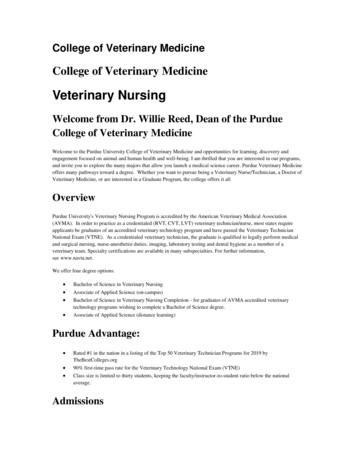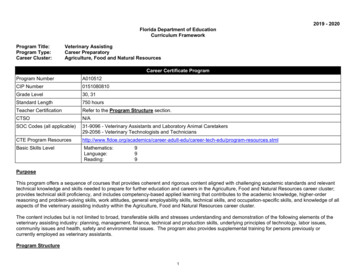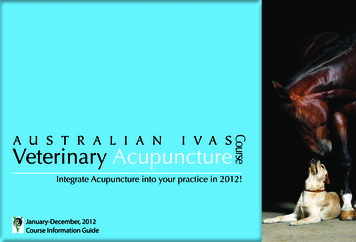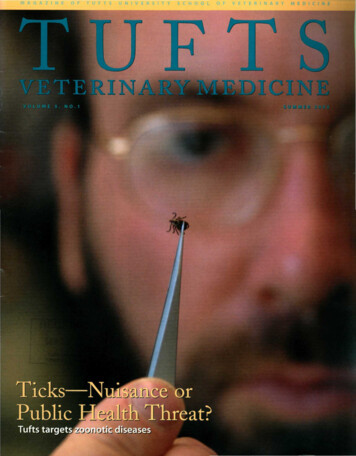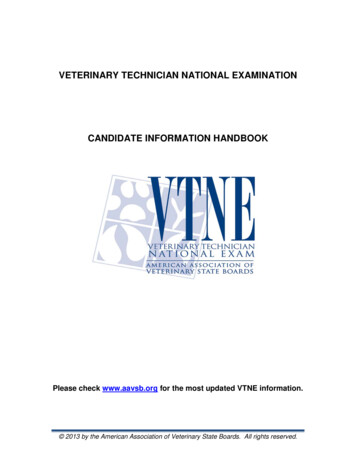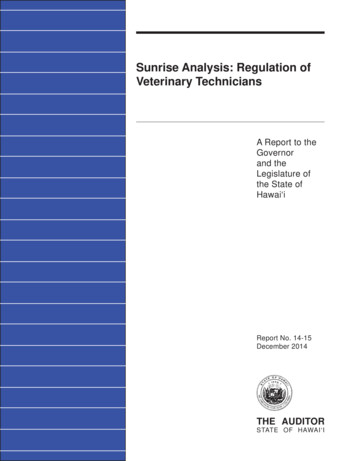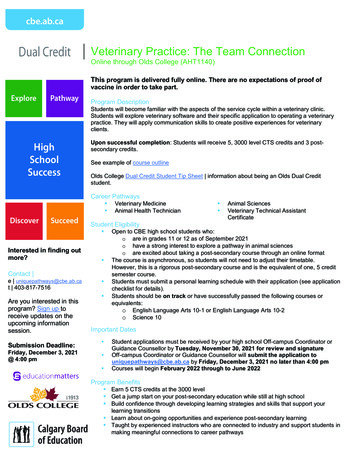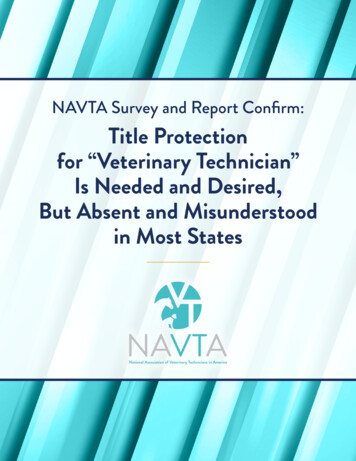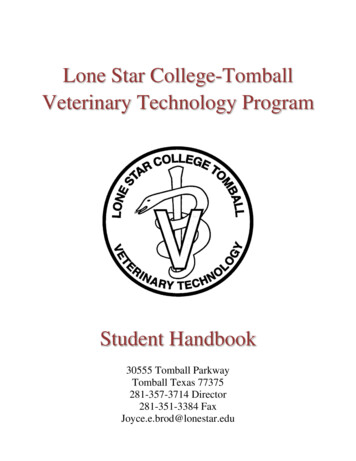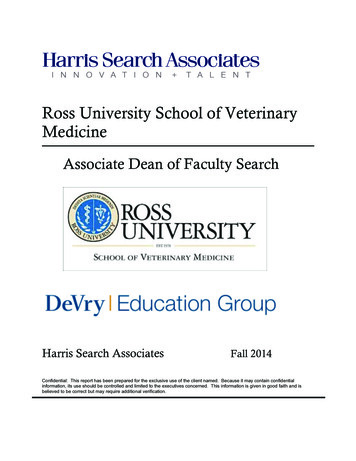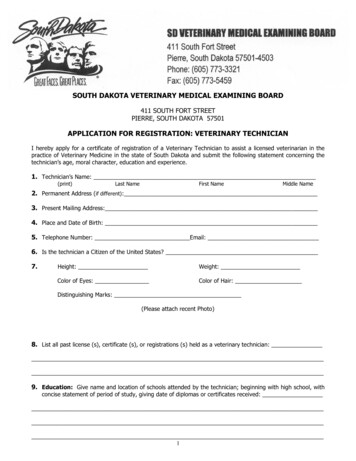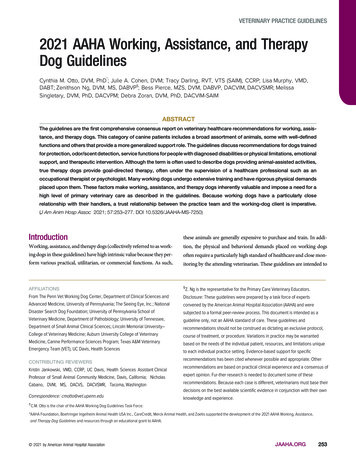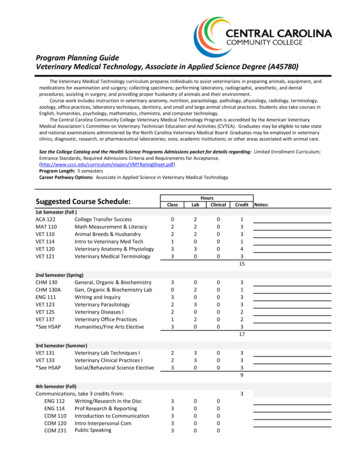
Transcription
Program Planning GuideVeterinary Medical Technology, Associate in Applied Science Degree (A45780)The Veterinary Medical Technology curriculum prepares individuals to assist veterinarians in preparing animals, equipment, andmedications for examination and surgery; collecting specimens; performing laboratory, radiographic, anesthetic, and dentalprocedures; assisting in surgery; and providing proper husbandry of animals and their environment.Course work includes instruction in veterinary anatomy, nutrition, parasitology, pathology, physiology, radiology, terminology,zoology, office practices, laboratory techniques, dentistry, and small and large animal clinical practices. Students also take courses inEnglish, humanities, psychology, mathematics, chemistry, and computer technology.The Central Carolina Community College Veterinary Medical Technology Program is accredited by the American VeterinaryMedical Association’s Committee on Veterinary Technician Education and Activities (CVTEA). Graduates may be eligible to take stateand national examinations administered by the North Carolina Veterinary Medical Board. Graduates may be employed in veterinaryclinics; diagnostic, research, or pharmaceutical laboratories; zoos; academic institutions; or other areas associated with animal care.See the College Catalog and the Health Science Programs Admissions packet for details regarding: Limited Enrollment Curriculum;Entrance Standards; Required Admissions Criteria and Requirements for VMTRatingSheet.pdf)Program Length: 5 semestersCareer Pathway Options: Associate in Applied Science in Veterinary Medical TechnologySuggested Course 033391st Semester (Fall )ACA 122MAT 110VET 110VET 114VET 120VET 121College Transfer SuccessMath Measurement & LiteracyAnimal Breeds & HusbandryIntro to Veterinary Med TechVeterinary Anatomy & PhysiologyVeterinary Medical Terminology2nd Semester (Spring)CHM 130CHM 130AENG 111VET 123VET 125VET 137*See HSAPGeneral, Organic & BiochemistryGen, Organic & Biochemistry LabWriting and InquiryVeterinary ParasitologyVeterinary Diseases IVeterinary Office PracticesHumanities/Fine Arts Elective3rd Semester (Summer)VET 131VET 133*See HSAPVeterinary Lab Techniques IVeterinary Clinical Practices ISocial/Behavioral Science Elective4th Semester (Fall)Communications, take 3 credits from:ENG 112Writing/Research in the DiscENG 114Prof Research & ReportingCOM 110 Introduction to CommunicationCOM 120 Intro Interpersonal ComCOM 231 Public Speaking3333330000000000Notes:
2 Program Planning GuideVeterinary Medical Technology, AAS (A45780)VET 126VET 211VET 213VET 215WBL 112ABVeterinary Diseases IIVeterinary Lab Techniques IIVeterinary Clinical Practices IIVeterinary PharmacologyWork-based Learning I12130339010000002343116212303930100000034331145th Semester (Spring)VET 212VET 214VET 217VET 237WBL 112BBVeterinary Lab Techniques IIIVeterinary Clinical Practices IIILarge Animal Clinical PracticesAnimal NutritionWork-based Learning II*HSAP, Health Sciences Admission PacketTotal Semester Hours Credit Required for Graduation:2019Fall71
Veterinary Medical Technology, AAS (A45780)Course DescriptionsACA 122College Transfer Success0-2-1This course provides information and strategies necessary todevelop clear academic and professional goals beyond thecommunity college experience. Topics include the CAA, collegepolicies and culture, career exploration, gathering information onsenior institutions, strategic planning, critical thinking, andcommunication skills for a successful academic transition. Uponcompletion, students should be able to develop an academic planto transition successfully to senior institutions. This course hasbeen approved for transfer under the CAA and ICAA as a premajorand/or elective course requirement.CHM 130General, Organic and Biochemistry3-0-3Local Corequisite: CHM 130AThis course provides a survey of basic facts and principles ofgeneral, organic, and biochemistry. Topics include measurement,molecular structure, nuclear chemistry, solutions, acid-basechemistry, gas laws, and the structure, properties, and reactions ofmajor organic and biological groups. Upon completion, studentsshould be able to demonstrate an understanding of fundamentalchemical concepts. This course has been approved for transferunder the CAA and ICAA a premajor and/or elective courserequirement.CHM 130AGeneral, Organic and Biochemistry Lab0-2-1Corequisite: CHM 130This course is a laboratory for CHM 130. Emphasis is placed onlaboratory experiences that enhance materials presented in CHM130. Upon completion, students should be able to utilize basiclaboratory procedures and apply them to chemical principlespresented in CHM 130. Also included are EMR,spectrophotometry, extraction, safety, and feed analysis. Thiscourse has been approved for transfer under the CAA and ICAA apremajor and/or elective course requirement.COM 110Introduction to Communication3-0-3This course provides an overview of the basic concepts ofcommunication and the skills necessary to communicate in variouscontexts. Emphasis is placed on communication theories andtechniques used in interpersonal group, public, intercultural, andmass communication situations. Upon completion, studentsshould be able to explain and illustrate the forms and purposes ofhuman communication in a variety of contexts. This course hasbeen approved for transfer under the CAA and ICAA as a generaleducation course in Communications.COM 120Intro Interpersonal Com3-0-0-3This course introduces the practices and principles ofinterpersonal communication in both dyadic and group settings.Emphasis is placed on the communication process, perception,listening, self-disclosure, speech apprehension, ethics, nonverbalcommunication, conflict, power, and dysfunctional communicationrelationships. Upon completion, students should be able todemonstrate interpersonal communication skills, apply basicprinciples of group discussion, and manage conflict ininterpersonal communication situations. This course has beenapproved for transfer under the CAA and ICAA as a premajorand/or elective course requirement.2019Fall 3 COM 231Public Speaking3-0-0-3This course provides instruction and experience in preparation anddelivery of speeches within a public setting and group discussion.Emphasis is placed on research, preparation, delivery, andevaluation of informative, persuasive, and special occasion publicspeaking. Upon completion, students should be able to prepareand deliver well-organized speeches and participate in groupdiscussion with appropriate audiovisual support. This course hasbeen approved for transfer under the CAA and ICAA as a generaleducation course in English Composition.ENG 111Writing and Inquiry3-0-3Prerequisites: Take one set: DRE-098 or appropriate placement testscores.This course is the required first course in a series of two designedto develop the ability to produce clear expository prose. Emphasisis placed on the writing process including audience analysis, topicselection, thesis support and development, editing, and revision.Upon completion, students should be able to produce unified,coherent, well-developed essays using standard written English.This course has been approved for transfer under the CAA andICAA as a general education course.ENG 112 Writing/Research in the Disciplines3-0-0-3Prerequisite: ENG 111This course, the second in a series of two, introduces researchtechniques, documentation styles, and writing strategies.Emphasis is placed on analyzing information and ideas andincorporating research findings into documented writing andresearch projects. Upon completion, students should be able toevaluate and synthesize information from primary and secondarysources using documentation appropriate to various disciplines.This course has been approved for transfer under the CAA andICAA as a universal general education transfer component (UGETC)course in English Composition.ENG 114 Professional Research and Reporting3-0-3Prerequisite: ENG 111This course, the second in a series of two, is designed to teachprofessional communication skills. Emphasis is placed onresearch, listening, critical reading and thinking, analysis,interpretation, and design used in oral and written presentations.Upon completion, students should be able to work individually andcollaboratively to produce well-designed business and professionalwritten and oral presentations. The computer is used as a writingand design tool for this course. This course has been approved fortransfer under the CAA and ICAA as a general education course inEnglish Composition.MAT 110Mathematical Measurement2-2-3Local RISE corequisites: Take one group: 1) MAT 010;2) MAT 003; 3) DAM 010, DMA 020, DMA 030; 4) MAT 060;5) DMA 025This course provides an activity-based approach that developsmeasurement skills and mathematical literacy using technology tosolve problems for non-math intensive programs. Topics includeunit conversions and estimation within a variety of measurementsystems; ratio and proportion; basic geometric concepts; financialliteracy; and statistics including measures of central tendency,dispersion, and charting of data. Upon completion, studentsshould be able to demonstrate the use of mathematics and
Veterinary Medical Technology, AAS (A45780)Course Descriptionstechnology to solve practical problems, and to analyze andcommunicate results.VET 110Animal Breeds and Husbandry2-2-3Local Prerequisite: Enrollment in Veterinary Medical TechnologyprogramThis course provides a study of the individual breed characteristicsand management techniques of the canine, feline, equine, bovine,porcine, ovine, caprine, and laboratory animals. Topics includephysiological data, animal health management, and basic care andhandling of animals. Upon completion, students should be able toidentify breeds of domestic and laboratory animals, listphysiological data, and outline basic care, handling, andmanagement techniques.VET 114 Introduction to Veterinary Medical Technology 1-0-1Local Prerequisite: Enrollment in Veterinary Medical TechnologyprogramThis course introduces the standard operating procedures andresponsibilities of veterinary medical technology departments,common zoonotic diseases, safety and ethical issues, andUSDA/DEA/OSHA regulations/compliance. Emphasis is placed onstandard operating procedures, zoonotic diseases, safety andethical issues, and the importance of USDA/DEA/OSHA regulationsand compliance. Upon completion, students should be able toperform duties assigned in veterinary medical technology,recognize potential zoonotic diseases, and establish safetyprotocols/regulatory compliance.VET 120 Veterinary Anatomy and Physiology3-3-4Local Prerequisite: Enrollment in the Veterinary MedicalTechnology program, Completion of one of the following: highschool biology course, BIO 090, BIO 094, BIO 110, BIO 111 or bypermission of the instructorThis course covers the structure and function of the animal bodywith emphasis on the similarities and differences among domesticanimals. Emphasis is placed on the structure and function of themajor physiological systems of domestic, laboratory, and zooanimals. Upon completion, students should be able to identifyrelevant anatomical structure and describe basic physiologicalprocesses for the major body systems.VET 121Veterinary Medical Terminology3-0-3Local Corequisite: Enrollment in Veterinary Medical TechnologyprogramThis course covers the basic medical terminology required forveterinary technicians. Topics include the pronunciation, spelling,and definition of word parts and vocabulary terms unique to theanatomy, clinical pathology, and treatment of animals. Uponcompletion, students should be able to demonstrate knowledgeand understanding of basic medical terms as they relate toveterinary medicine.VET 123Veterinary Parasitology2-3-3Local Prerequisite: VET 120This course covers the common internal and external parasites ofcompanion animals, livestock, selected zoo animals, and wildanimals. Emphasis is placed on laboratory diagnosis of the mostcommon forms of the parasite through fecal, urine, skin, andblood exams. Upon completion, students should be able to2019Fall 4 identify common parasites and discuss life-cycles, treatment andprevention strategies, and public health aspects of veterinaryparasitology.VET 125Veterinary DiseasesI 2-0-2Local Prerequisite: VET 120This course introduces basic immunology, fundamentals of diseaseprocesses including inflammation, and common infectiousdiseases of animals and their prevention through immunization.Topics include fundamental disease processes, principles ofmedical therapy, immunologic processes, infections and zoonoticdiseases of domestic animals, and prevention of disease. Uponcompletion, students should be able to describe basic disease andimmunological processes, recognize infections and zoonoticdiseases, and discuss prevention strategies.VET 126Veterinary Diseases II1-3-2Prerequisite: VET 125This course includes the study of basic disease processes,fundamentals of pathology, and other selected topics of veterinarymedicine. Topics include histopathology, pathologic changesassociated with common diseases of animals, necropsyprocedures, specimen handling. Upon completion, studentsshould be able to describe basic pathologic changes associatedwith disease, recognize histopathologic changes, and properlyperform collection and submission of necropsy specimens.VET 131Veterinary Laboratory Techniques I2-3-3Prerequisite: VET 123Corequisite: VET 133This course includes the fundamental study of hematology,hemostasis, and urinalysis. Emphasis is placed on basichematology and urinalysis techniques, manual skill development,instrumentation, quality control, and applications to veterinaryscience. Upon completion, students should be able to performmanual and automated CBCs, hemostatic assays, and completeurinalyses and maintain laboratory equipment and quality control.VET 133Veterinary Clinical Practice I2-3-3Local Prerequisite: VET 123Local Corequisite: VET 131Corequisite: VET 120This course introduces basic practices and techniques of theveterinary clinic and biomedical research fields for dogs, cats, andlaboratory animals. Topics include physical exam, husbandry,housing, sanitation, restraint and handling, administration ofmedications, anesthesia and euthanasia techniques, grooming,and dentistry. Upon completion, students should be able toproperly restrain, medicate, examine, groom, and maintain eachof the species studied.VET 137Veterinary Office Practices1-2-2Local Prerequisites: VET 131, VET 133, Enrollment in VeterinaryMedical Technology programThis course is designed to teach basic administrative techniques,client communication skills, and regulations pertaining toveterinary medicine. Topics include record keeping, telephonetechniques, professional liability, office procedures, state andnational regulatory laws, human relations, and animal welfare.Upon completion, students should be able to demonstrate
Veterinary Medical Technology, AAS (A45780)Course Descriptions 5 effective communication techniques, office procedures, andknowledge of regulatory laws and issues relating to animalwelfare.students should be able to properly calculate and administermedications, recognize adverse reactions, and maintainpharmaceutical inventory and administration records.VET 211Veterinary Laboratory Techniques II2-3-3Prerequisite: VET 131Corequisite: VET 213This course covers advanced hematology, serology, immunology,and clinical chemistry. Topics include advanced hematologic,serologic, and immunologic test procedures; manual andautomated clinical chemistry procedures; laboratory safety; andquality control. Upon completion, students should be able tocollect, prepare, and analyze serum and plasma samples andoutline quality control and safety procedures.VET 217Large Animal Clinical Practice2-3-3Prerequisite: VET 120Local Prerequisite: VET 125Corequisite: VET 213Local Corequisite: VET 214This course covers topics relevant to the medical and surgicaltechniques for the common domestic large animal species. Topicsinclude physical exam, restraint, sample collection, bandaging,emergency treatment, surgical and obstetrical procedures andinstruments, herd health, and lameness topics. Upon completion,students should be able to safely perform restraint, examination,and sample collection; assist surgical, obstetrical, and emergencyprocedures; and discuss herd health.VET 212Veterinary Laboratory Techniques III2-3-3Prerequisite: VET 211Corequisite: VET 214This course introduces the basic principles of microbiology,histology, and cytology. Emphasis is placed on collection ofmicrobiological samples for culture and sensitivity and collectionand preparation of samples for histological and cytologicalexamination. Upon completion, students should be able toperform microbiological culture and sensitivity and evaluatecytology and histology specimens.VET 213Veterinary Clinical Practice II1-9-4Prerequisite: VET 133Local Corequisite: VET 211This course covers basic radiography, anesthesia techniques,dentistry, sample collection and handling, surgical assistance andinstrumentation, sterile techniques, and patient record keeping.Topics include basic radiography, injectable and gas anesthesia,dentistry, instrument identification and care, sterile surgicaltechnique, specimen collection and processing, and maintenanceof patient records. Upon completion, students should be able totake and process radiographs, administer and monitor anesthesia,assist in surgical procedures, collect specimens, and maintainsurgical records.VET 214Veterinary Clinical Practice III1-9-4Prerequisite: VET 213Local Corequisite: VET 212This course covers advanced anesthetic techniques, specialradiographic techniques, advanced dentistry, sample collectionand processing, bandaging, and emergency and critical careprocedures. Topics include induction and maintenance ofanesthesia, radiographic contrast studies, advanced dentistry,external coaptation, intensive care procedures, and advancedsample collection techniques. Upon completion, students shouldbe able to demonstrate proficiency in sample collection, radiology,anesthesia, critical care and emergency procedures, and dentistry.VET 215Veterinary Pharmacology3-0-3Prerequisites: CHM 130 and CHM 130A or CHM 151Corequisite: VET 213This course introduces drugs and other substances utilized inveterinary medicine. Emphasis is placed on drug classification andmethods of action, administration, effects and side effects, storingand handling of drugs, and dosage calculations. Upon completion,2019FallVET 237Animal Nutrition3-0-3Local Prerequisites: CHM 130 and CHM 130A; enrollment inVeterinary Medical Technology programThis course covers the principles of nutrition and their applicationto feeding practices of domestic, farm, and companion animals.Topics include basic nutrients and nutritional needs of individualspecies, proximate analysis, interpretation of food and feed labels,types of animal foods, and ration formulation. Upon completion,students should be able to select appropriate diets for animals invarious stages of health and disease, analyze nutrition labels, andidentify foods.WBL 112ABWork-Based Learning I0-0-10-1This course provides a work-based learning experience with acollege-approved employer in an area related to the student'sprogram of study. Emphasis is placed on integrating classroomlearning with related work experience. Upon completion, studentsshould be able to evaluate career selection, demonstrateemployability skills, and satisfactorily perform work-relatedcompetencies.WBL 112BBWork-Based Learning I0-0-10-1This course provides a work-based learning experience with acollege-approved employer in an area related to the student'sprogram of study. Emphasis is placed on integrating classroomlearning with related work experience. Upon completion, studentsshould be able to evaluate career selection, demonstrateemployability skills, and satisfactorily perform work-relatedcompetencies.
porcine, ovine, caprine, and laboratory animals. Topics include physiological data, animal health management, and basic care and handling of animals. Upon completion, students should be able to identify breeds of domestic and laboratory animals, list physiological data, and outline basic care, handling, and management techniques.
